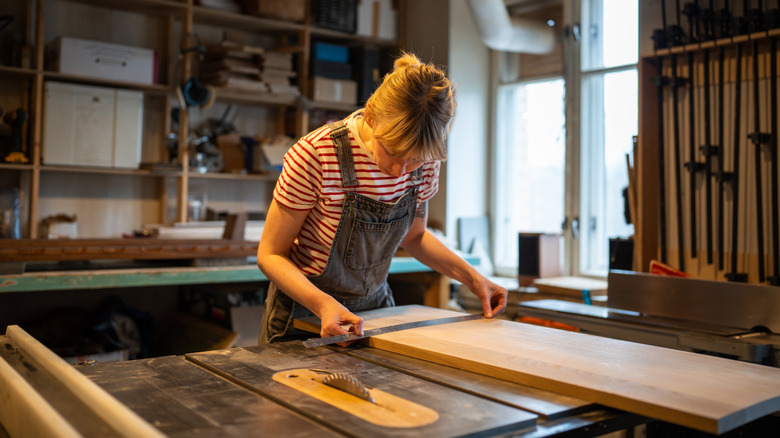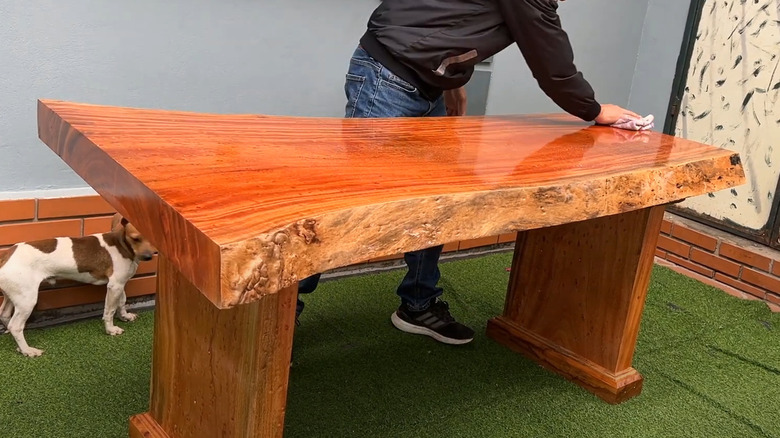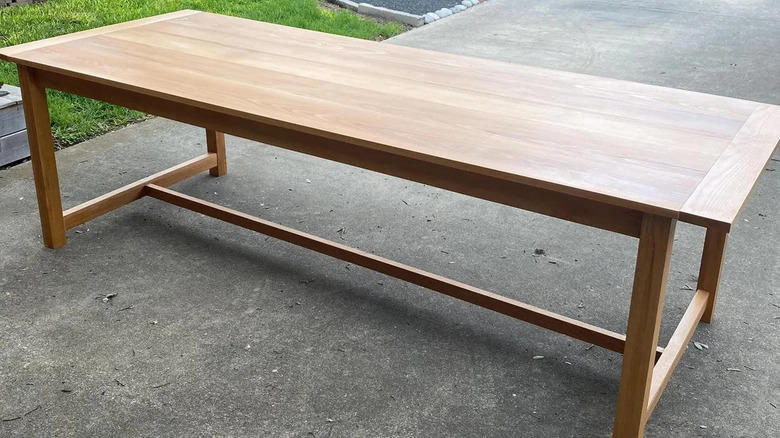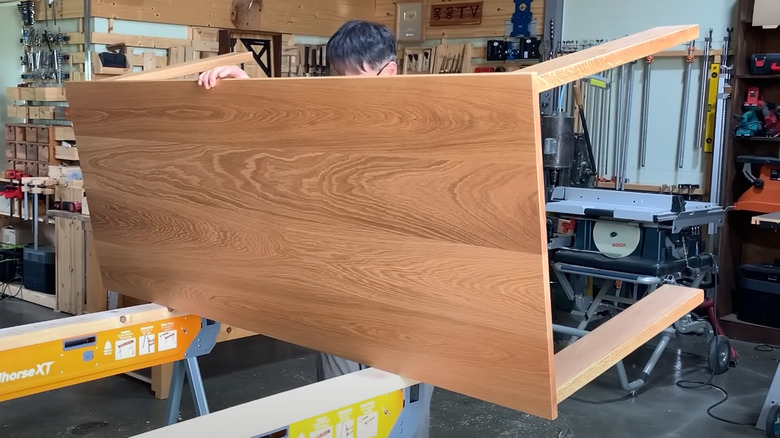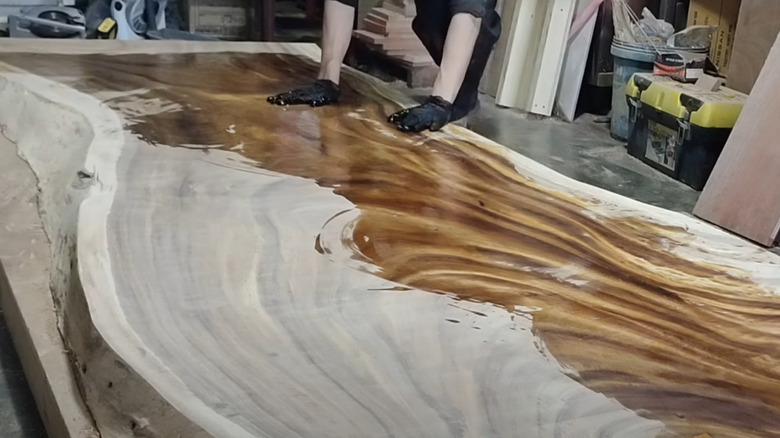The 8 Best Types Of Wood For A DIY Dining Table
We may receive a commission on purchases made from links.
Dining tables have a simple base design with their frame, legs, and tabletop. DIYing a dining room table is a great project for beginners and adept woodworkers and has a highly rewarding result that can last for decades if you're smart about building the table. The first step is determining which type of wood to use, and it can be intimidating to decide between all the hardness levels and grain patterns.
Below are eight wood species with qualities ideal for carpentry projects. All of them come from hardwood trees and have Janka wood hardness ratings suitable for table components; the standard that rates wood based on how resistant they are to damage. All of these woods have commendable ratings or can be finished and sealed to render them more durable, making them guaranteed long-term and damage-resistant tabletop and table frame options. As you read, you'll discover that even the hardest materials have their cons but also have multiple characteristics that are desirable for building furniture. They're rot, insect, and water resistant, budget-friendly, take stains and finishes easily, or are easy to assemble with wood glue.
While no wood has all of the best characteristics, it helps to know the pros and cons of each one to determine which is the best for your intentions. Pick a wood within your skill level that best suits your household situation, as this ensures a handcrafted masterpiece lasts long-term. Even if you remodel your dining area in the future, there are ways to repurpose your old beloved dining table without having to throw it out. Read on to learn about the eight best types of wood to hand-make a table for your home.
Poplar wood is easy to work with and makes attractive table-tops for low-traffic households
Beginner DIYers should start with a wood that's malleable but still classified as hardwood. Poplar wood has a lovely beige to brown coloring that darkens with age and a straight, fine grain, making it a great fit for various interior design styles. It sports a rating of 540 on the Janka scale, putting it on the lower end as far as hardwoods go, but it still deserves a spot on this list because of its ease of use for beginners.
The composition of poplar wood is easy to cut for two reasons; the density and uniform grain. It's still dense enough to provide a solid table base and easier to cut through with hand tools. Poplar doesn't require special carbide drill bits or saw blades, it doesn't dull tools as quickly, and it's easy to screw and nail together. Despite being forgiving to work with, poplar isn't easy to finish — it doesn't absorb finishes well. The best way to use poplar wood to DIY a table would be to use it as the table frame or legs. Then, add another slab of more durable and impact-resistant hardwood on top. Another pro of using poplar wood is that it's budget-friendly, so your dream dining table DIY doesn't have to cost a fortune. It's priced at around $3.90 per board foot, which is highly affordable compared to high-end imported options that go as high as $45.05 per board foot.
Grade-A teak wood is highly resistant to insects and rot and often used in outdoor furniture sets
Grade-A teak wood is often used in outdoor applications, such as patio and porch furniture sets. Naturally, this implies it's more than capable of serving as an indoor dining table. With a golden to medium brown color that darkens with age, teak wood comes in various grain patterns, including straight, wavy, and interlocked. It has a Janka rating of about 1,070 and is highly resistant to termites, mold and mildew, and moisture. It doesn't need paint or finish to withstand outdoor weather, making it a great DIY project for those who want to leave the wood in a natural state or finish with a natural sealant like tung oil when used as an interior dining table.
With its high quality and long-lasting nature, teak wood's biggest downside is the cost. Expect to pay around $25 per board foot for quality material, roughly six times the price of poplar wood. It's also a good thing this type of wood doesn't need a final top coat — its natural oils repel finishing coats, making it difficult to seal the surface. This also makes staining difficult, rendering it hard to change the color to your preferences. There are other hidden disadvantages of teak wood you need to know about, but as long as you find quality kiln-dried grade-A wood, it can be worth the price.
Black walnut comes in an array of color and grain patterns for vibrant tabletop designs
Black walnut wood is remarkable for its dynamic pale brown to chocolate hues (which can also contain purple, reddish, or even gray undertones), making it popular in classic and modern room themes. The rich coloring pairs with various grain patterns, from straight to burling and knotted designs. It has a 1,010 Janka hardness rating and is highly resistant to rot but not insects. Therefore, it's a great wood slab for a DIY indoor table where ants, beetles, and termites aren't present. As the surface faces natural wear and tear over time, there are also (ironically) walnut hacks to bring your wood furniture back to life and restore the color using walnut shells.
Black walnut is relatively easy to shape and assemble despite its dense Janka rating. Wood glue works well with this wood type and black walnut also absorbs finishes and stains without issue, making it easy to darken or seal the wood to your exact preferences. It's usually around $12 to $15 per board foot, putting it in the mid-price range for lumber.
Authentic birch wood is affordable, sustainable, and one of the hardiest wood types for furniture
Birch wood has many similarities to poplar wood when used to craft furniture. Its lumber is most recognized by a pale whitish beige coloring, but it also comes in warm brown shades with a fine, straight grain. This wood yellows as it ages, and its coloring befits modern, Scandinavian, and coastal themes. Even if you don't have a coastal or modern-themed dining room, birch is a great choice for a dining table DIY project. Like poplar, it's often used for framing rather than visible tabletops. However, it's categorized high on the Janka scale with a 1,260 rating (and is often used in butcher block) so if you like the grain pattern, there's no reason why you can't try using it for the top as well.
If you want to alter the color of the wood, one drawback to birch is that it's highly porous. This can cause dark stains to absorb unevenly and create a blotchy effect. Using a pre-stain conditioner is one way to help prevent this. It's also very affordable, given the high Janka rating, at around $5 per board foot. One useful carpenter tip is to ask for imported birch instead of Baltic birch – imported birch is more readily available and fetches a lower price, providing a better deal on the cost of material for your dining table.
Red and white oak tables are highly resistant to common wood risks and have been used for centuries
There's a reason why oak wood has been used for furniture crafting since the Middle Ages and beyond. Both red and white oak trees provide sturdy and gorgeous lumber, ideal for DIY dining tables. Red oak is recognizable for its warm brown color tinged with red and pink hues and typically has a more marked grain pattern. White oak is a lighter brown with gray and yellow undertones, and tends to have a more subtle grain pattern. With a Janka rating ranging from 1,290 to 1,360, red and white oak wood have the ideal convergence of being extremely durable but still workable. Both varieties are also insect and rot-resistant, giving them a perk over hardwood types like meranti and maple.
If you simply want to build the most solid oak table possible, then white oak could be the better pick as it's harder and more water-resistant than red oak, rendering it a good choice for a high-use dining area. There is the caveat that red oak is easier to find, as this species grows faster than white oaks and is in higher demand. Given its availability, red oak is also cheaper and about half the price of its counterpart, making it a better choice for DIYers on a budget. Red oak is on the low end at about $4.50 to $6 per board foot, while white oak costs veer toward $11 to $17.30, depending on the sawing method. It also cuts smoothly and is easy to work with.
Hard maple is relatively affordable and can make a long-lasting table for busy households
Hard maple popular amongst many carpenters and DIYers because it's a versatile type of wood that works for a variety of home projects. It's light in color, and there isn't much variation between the heartwood and sapwood. The grain tends to be straight and consistent, making it popular for sleek, quiet designs where you don't want a bold wood grain to take over the show. Hard maple has a 1,450 Janka rating, and is often used for surfaces that are destined to take a beating, like flooring, butcher block, workbenches, and even bowling alleys. This tough native hardwood isn't resistant to rot and insect damage, but for an indoor dining table that's properly sealed, this shouldn't be an issue.
The high Janka rating means this wood is incredibly durable and heavy, which can make it tricky to work with. Hand tools might not be sufficient for cutting and shaping the wood, and it can take a lot more patience, time, and precision. If using a router or electric planer, be careful not to burn the maple, a common mishap caused if the blades are moving too fast. Once the cutting and assembly stage is over, you'll need to think carefully about staining. Hard maple has the potential for blotching and uneven absorption, so if you choose to go this route you'll definitely want to apply a preconditioner, like Minwax's Clear Pre-Stain Oil-Based Wood Conditioner. Alternatively, you can also opt to use a wood dye, such as one of the more natural-toned TransTint Dyes, which can give more even results. As far as costs go, this is another budget-friendly hardwood option, costing about $6 to $12.50 per board foot.
Acacia wood has distinct wood patterns that make for one-of-a-kind furniture pieces
There is a sustainable wood material you'll want to use everywhere in your home, and that is acacia wood. The heartwood is a light to medium brown with pink undertones, and it darkens as it ages. The grain is interlocked and varies from straight to curly, making each wood board truly one-of-a-kind. The gorgeous and striking wood slabs have a whopping 1,750 Janka hardness rating, though certain acacia species go even higher than that. It's used to craft instruments, boats, railroad ties, and more, showing how multifaceted it can be. Acacia is also similar to teak in that it's highly resilient against weather and other outdoor risks such as insects and rot. Inside, an acacia table can last a lifetime (and longer) and the wood is highly scratch resistant.
There are about 1,350 acacia species, and deciding which one to use for a dining table project can be overwhelming. Acacia koa is a premium choice, and works well for creating sturdy and unique pieces since the graining is so varied — but isn't as widely available in continental U.S. as hardwoods like maple. Despite its high Janka rating, acacia can be surprisingly workable, however the interlocking grain pattern can add an additional challenge, and sharp tools are a must. Acacia species do require a medium budget, costing about $13 to $15 per board foot, and prices can range higher for rare species.
Brazilian cherry is extremely hard and rich in color
Brazilian cherry (known more correctly as jotoba) ranges from a reddish pink to deep red and rich orange-browns, with darker striping that veers towards gray and black. It has a fine and detailed interlocking grain pattern that makes for a beautiful table surface. The heartwood rates at around 2,350 on the Janka hardness scale, though some trees and wood slabs are even stronger. Brazilian cherry can be sanded and refinished many times to preserve its beauty long-term. It's also more resistant to moisture and pests than other wood types.
There's no doubt that Brazilian cherry makes a beautiful dining table, and it isn't too costly, even though it's of superb quality. Brazilian cherry runs between $10 to $13 per board foot. However, the interlocking grain and denseness are trickier to DIY than other woods, and is better suited to budding woodworkers who already have a series of projects under their toolbelt. Beginners may struggle to cut through the wood, which is notorious for dulling tools throughout the process, and can also cause tearout. Use carbide drill bits or saw blades, such as the WEN Fine-Finish Professional Woodworking Saw Blade, which are tougher and remain sharper for longer. Planing the wood to a fine finish can also be tricky due to the grain texture. In short, this is an ideal wood for a luxurious dining table, but it is harder to work with than other options on this list. If you've never handcrafted a table before, start with another wood before setting out to work Brazilian cherry boards.
